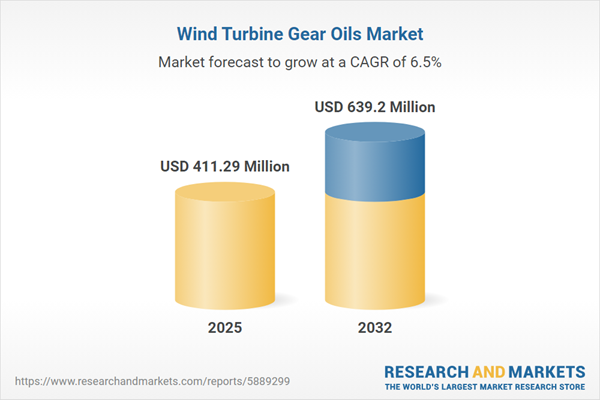Speak directly to the analyst to clarify any post sales queries you may have.
The wind turbine gear oils market is undergoing a rapid transformation as operators and manufacturers prioritize performance, reliability, and sustainability to maximize wind asset returns. Continuous advancements in lubricant chemistry and maintenance strategies are crucial for driving operational excellence in contemporary wind energy infrastructure.
Market Snapshot: Wind Turbine Gear Oils Market Growth and Trajectory
The Wind Turbine Gear Oils Market grew from USD 387.39 million in 2024 to USD 411.29 million in 2025. It is expected to continue growing at a CAGR of 6.45%, reaching USD 639.20 million by 2032.
Scope & Segmentation
This research delivers a thorough analysis of all critical segmentations and regional domains shaping sector strategies:
- Product Types: Mineral Gear Oil, Synthetic Gear Oil (Ester Based, PAO Based)
- Turbine Configurations: Horizontal Axis, Vertical Axis
- Functionalities: High Load Gear Oils, Low Friction Gear Oils, Multi-Purpose Gear Oils
- Additive Classes: Anti-Wear Additives, Extreme Pressure Additives, Oxidation Stabilizers, Rust and Corrosion Inhibitors
- Applications: Industrial, Offshore, Onshore
- End User Verticals: Energy Sector, Industrial Sector, Utilities
- Geographies Covered: Americas (North America including United States, Canada, Mexico; Latin America including Brazil, Argentina, Chile, Colombia, Peru), Europe, Middle East & Africa (notably United Kingdom, Germany, France, Russia, Italy, Spain, Netherlands, Sweden, Poland, Switzerland, United Arab Emirates, Saudi Arabia, Qatar, Turkey, Israel, South Africa, Nigeria, Egypt, Kenya), and Asia-Pacific (including China, India, Japan, Australia, South Korea, Indonesia, Thailand, Malaysia, Singapore, Taiwan)
- Industry Participants Profiled: Afton Chemical, Amsoil Inc., BASF SE, Castrol Ltd., Chevron Corporation, ENEOS Corporation, Exxon Mobil Corporation, FUCHS Group, HollyFrontier Corporation, Idemitsu Kosan Co., IKV Group, IndianOil Corporation Limited, Kluber Lubrication, Nordex SE, Petronas Lubricants International, Phillips 66 Lubricants, PJSC Lukoil Oil Company, Royal Dutch Shell PLC, Schaeffler India Limited, Sinopec Corp., TotalEnergies S.A., Valvoline Inc., Freudenberg SE
Key Takeaways for Decision-Makers
- Market momentum is being reshaped by evolving formulations, most notably the industry-wide shift from mineral-based to high-performance synthetic lubricants as turbines increase in complexity and scale.
- Operators and suppliers are integrating predictive analytics and condition-based maintenance to optimize gear oil usage, maximize uptime, and reduce lifecycle costs for wind assets.
- Sustainability-focused procurement policies are influencing lubricant choices, propelling adoption of solutions with improved biodegradability and environmentally responsible additives.
- Leading manufacturers are emphasizing co-development partnerships with gearbox OEMs to ensure lubricants are tailored to specific turbine designs and operational environments.
- Regional markets display differing levels of maturity, with established supply chains and rigorous environmental standards in the Americas and Europe, and a focus on rapid capacity growth and standardization in the Asia-Pacific domain.
Tariff Impact: Navigating New US Trade Barriers
Newly imposed United States tariffs on imported industrial lubricants in 2025 are prompting stakeholders to adjust sourcing, cost management, and production strategies. Manufacturers are actively pursuing localized blending operations and reassessing supplier networks to maintain price stability and resilient gear oil supply for critical wind farm deployments.
Methodology & Data Sources
The research utilizes a combination of extensive secondary analysis and targeted primary interviews with lubricant chemists, turbine engineers, maintenance professionals, and procurement leaders. Cross-validation and analytical frameworks underpin robust market insights, while regional feedback ensures a comprehensive view of operational, regulatory, and technical variables influencing sector trends.
Why This Report Matters
- Enables senior leaders to benchmark technology adoption, procurement choices, and partnership models for optimal gear oil performance.
- Equips strategic planners with actionable intelligence on regional risks, regulatory developments, and supply chain adjustments.
- Supports operational teams with granular segmentation and real-world best practices to enhance reliability, cost savings, and sustainability initiatives.
Conclusion
This report empowers decision-makers to adapt lubrication strategies amid shifting regulatory, technological, and market dynamics. Forward-looking analysis ensures stakeholders are positioned to capitalize on innovation and regional growth opportunities within the wind turbine gear oils market.
Additional Product Information:
- Purchase of this report includes 1 year online access with quarterly updates.
- This report can be updated on request. Please contact our Customer Experience team using the Ask a Question widget on our website.
Table of Contents
3. Executive Summary
4. Market Overview
7. Cumulative Impact of Artificial Intelligence 2025
Companies Mentioned
The companies profiled in this Wind Turbine Gear Oils market report include:- Afton Chemical
- Amsoil Inc.
- BASF SE
- Castrol Ltd.
- Chevron Corporation
- ENEOS Corporation
- Exxon Mobil Corporation
- FUCHS Group
- HollyFrontier Corporation
- Idemitsu Kosan Co., Ltd.
- IKV Group
- IndianOil Corporation Limited
- Kluber Lubrication
- Nordex SE
- Petronas Lubricants International
- Phillips 66 Lubricants
- PJSC Lukoil Oil Company
- Royal Duthch Shell PLC
- Schaeffler India Limited
- Sinopec Corp.
- TotalEnergies S.A.
- Valvoline Inc.
- Freudenberg SE
Table Information
| Report Attribute | Details |
|---|---|
| No. of Pages | 188 |
| Published | November 2025 |
| Forecast Period | 2025 - 2032 |
| Estimated Market Value ( USD | $ 411.29 Million |
| Forecasted Market Value ( USD | $ 639.2 Million |
| Compound Annual Growth Rate | 6.4% |
| Regions Covered | Global |
| No. of Companies Mentioned | 24 |









